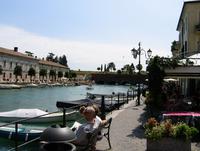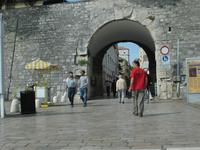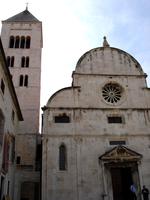You are in: Europe -> Italy -> Venetian Works of De... , and traditional search or Image Gallery will yield results of this site only
Venetian Works of Defence between the 16th and 17th Centuries: Stato da Terra – Western Stato da Mar
| Site number: | 1533 |
|
| Type of site: | Cultural | |
| Date of Inscription: | 2017 | |
| Location: | Europe, Italy, Croatia, Montenegro, Lombard region, Adriatic Coast | |
Up to 75 images are shown here. Click on each for more details or on Image Gallery for more images.
| Description: | This property consists of 15 components of defence works in Italy, Croatia and Montenegro, spanning more than 1,000 kilometres between the Lombard region of Italy and the eastern Adriatic Coast. The fortifications throughout the Stato da Terraprotected the Republic of Venice from other European powers to the northwest and those of the Stato da Mar protected the sea routes and ports in the Adriatic Sea to the Levant. They were necessary to support the expansion and authority of the Serenissima. The introduction of gunpowder led to significant shifts in military techniques and architecture that are reflected in the design of so-called alla modernaI bastioned, fortifications, which were to spread throughout Europe. --WHMNet's description is from WHC Site, where additional information is available. CC BY-SA 3.0. | |
| Palmanova - Palmanova (Friulian: Palme) is a town and comune in northeastern Italy. The town is an excellent example of star fort of the Late Renaissance, built up by the Venetians in 1593. The fortifications were included in UNESCO's World Heritage Site list as part of Venetian Works of Defence between 15th and 17th centuries: Stato da Terra – western Stato da Mar in 2017. Bergamo - Bergamo (Italian: [ˈbÉ›rÉ¡amo] listen (help·info); Lombard: Bèrghem, listen (help·info)) is a city in Lombardy, northern Italy, about 40 km (25 mi) northeast of Milan, 30 km (19 mi) from the lakes Como and Iseo, 80 km from the lakes Garda and Maggiore. The foothills of the Bergamo Alps begin immediately north of the town. The historic core of the city (upper city) includes several monuments and museums, and the Venetian defensive systems are a UNESCO World Heritage Site since 9 July 2017. Peschiera del Garda - Peschiera del Garda [peˈskjɛːra del ˈɡarda] (Venetian: Pischera; Latin: Ardelica, Arilica) is a town and comune in the province of Verona, in Veneto, Italy. When Lombardy-Venetia was under Austrian rule, Peschiera was the northwest anchor of the four fortified towns constituting the Quadrilatero. The fortress is on an island in the river Mincio at its outlet from Lake Garda. --Wikipedia. Text is available under the Creative Commons Attribution-ShareAlike License. CC BY-SA 3.0. |
||
| St. Nicholas Fortress - St. Nicholas Fortress (Croatian: TvrÄ‘ava Sv. Nikole) is a fortress located in the town of Šibenik, one of the oldest native Croatian towns on the eastern shores of the Adriatic, in central Dalmatia, Croatia. It was included in UNESCO's World Heritage Site list as part of "Venetian Works of Defence between 15th and 17th centuries: Stato da Terra – western Stato da mar" in 2017. Zadar - Zadar (pronounced [zâdar]; see other names) is the oldest continuously inhabited city in Croatia. It is situated on the Adriatic Sea, at the northwestern part of Ravni Kotari region. Zadar serves as the seat of Zadar County and the wider northern Dalmatian region. The city proper covers 25 km2 (9.7 sq mi) with a population of 75,082 in 2011, making it the fifth-largest city in the nation. The area of present-day Zadar traces its earliest evidence of human life from the late Stone Age, while numerous settlements have been dated as early as the Neolithic. Before the Illyrians, the area was inhabited by an ancient Mediterranean people of a pre-Indo-European culture. Zadar traces its origin to its 4th-century BC founding as a settlement of the Illyrian tribe of Liburnians known as Iader… Today, Zadar is a historical center of Dalmatia, Zadar County's principal political, cultural, commercial, industrial, educational, and transportation centre. Zadar is also the seat of the Roman Catholic Archdiocese of Zadar. Because of its rich heritage, Zadar is today one of the most popular Croatian tourist destinations, named "entertainment center of the Adriatic" by The Times and "Croatia's new capital of cool" by the Guardian.[1] In 2016, Zadar was named "Best European Destination" by the Belgian portal Europe's Best Destinations.com after a three-week period of online voting and more than 288,000 cast votes. Kotor - Kotor (Montenegrin Cyrillic: Котор, pronounced [kɔ̌tÉ”r]) is a coastal town in Montenegro. It is located in a secluded part of the Gulf of Kotor. The city has a population of 13,510 and is the administrative center of Kotor Municipality. The old Mediterranean port of Kotor is surrounded by fortifications built during the Venetian period. It is located on the Bay of Kotor (Boka Kotorska), one of the most indented parts of the Adriatic Sea. Some have called it the southern-most fjord in Europe, but it is a ria, a submerged river canyon. Together with the nearly overhanging limestone cliffs of Orjen and Lovćen, Kotor and its surrounding area form an impressive and picturesque Mediterranean landscape. In recent years, Kotor has seen an increase in tourists, many of them coming by cruise ship. Visitors are attracted by the natural environment of the Gulf of Kotor and by the old town of Kotor. Kotor is part of the World Heritage Site dubbed the Natural and Culturo-Historical Region of Kotor. The fortified city of Kotor was also included in UNESCO's World Heritage Site list as part of Venetian Works of Defence between 15th and 17th centuries: Stato da Terra – western Stato da Mar in 2017. --Wikipedia. Text is available under the Creative Commons Attribution-ShareAlike License. CC BY-SA 3.0. |
||
| Source: | http://whc.unesco.org/en/list/1533. Description is available under license. CC-BY-SA IGO 3.0 | |
| Source2: | Wikipedia (http://wikipedia.com). CC BY-SA 3.0. | |
| Reference: | 1. UNESCO World Heritage Center (http://whc.unesco.org/en/list/1533). 2. Wikipedia. CC BY-SA 3.0. | |



































































